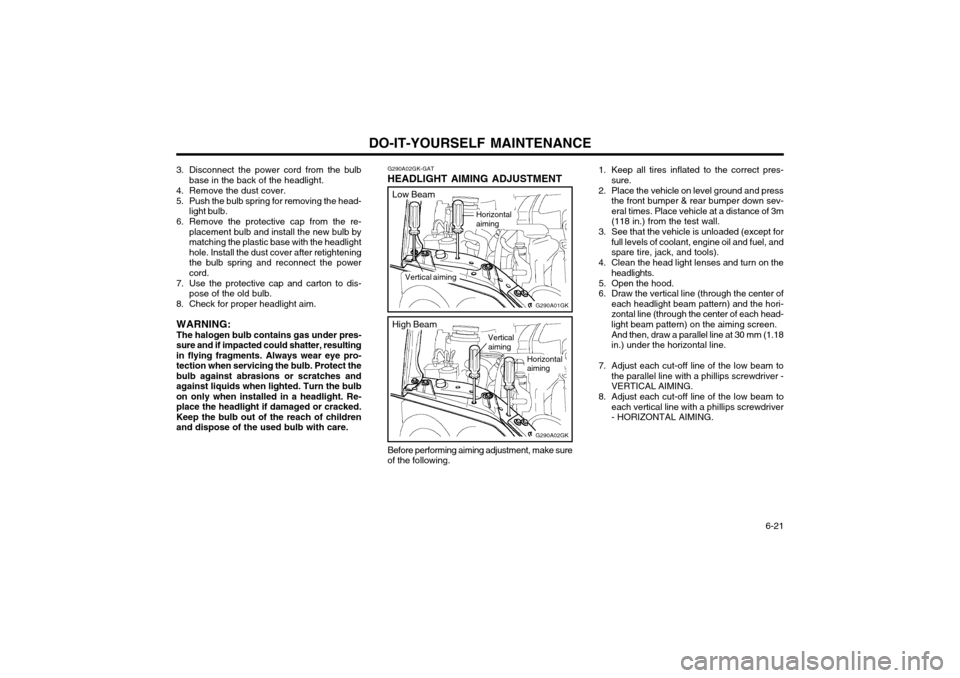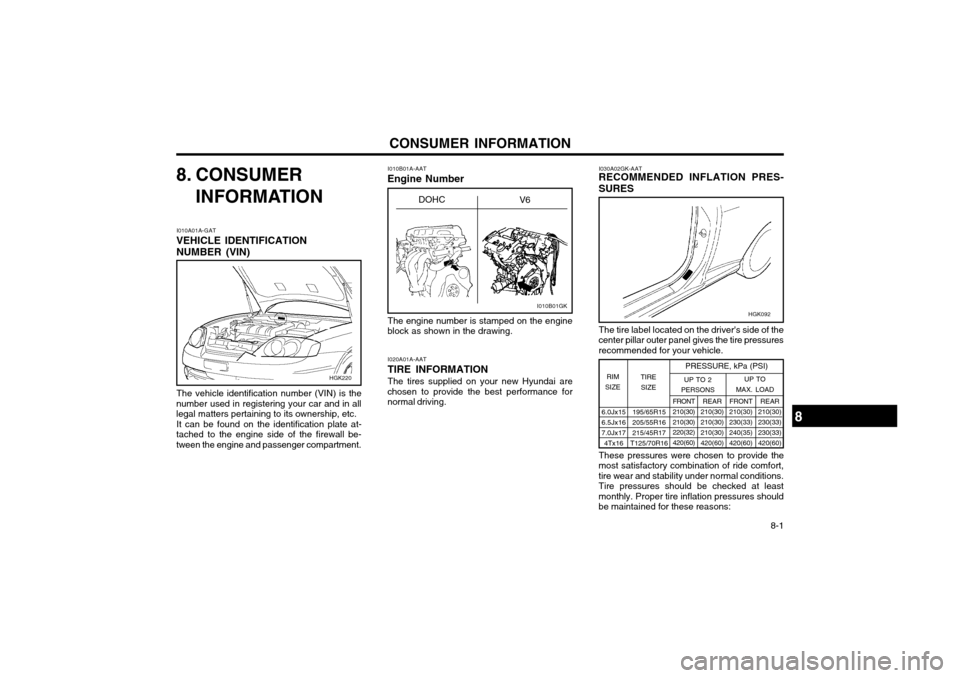Hyundai Coupe 2004 Owner's Manual
Manufacturer: HYUNDAI, Model Year: 2004, Model line: Coupe, Model: Hyundai Coupe 2004Pages: 389, PDF Size: 10.22 MB
Page 151 of 389

DO-IT-YOURSELF MAINTENANCE 6-19
CAUTION: A burned-out fuse indicates that there is a
problem in the electrical circuit. If you re- place a fuse and it blows as soon as theaccessory is turned on, the problem is seri-ous and should be referred to a Hyundaidealer for diagnosis and repair. Never re-place a fuse with anything except a fusewith the same or a lower amperage rating. Ahigher capacity fuse could cause damageand create a fire hazard.
NOTE: See page 6-23 for the fuse panel descrip-
tions.
Burned out
G200B03YGood G210A01A-AAT
CHECKING THE BATTERY
WARNING: Batteries can be dangerous! When working
with batteries, carefully observe the follow- ing precautions to avoid serious injuries.
The fluid in the battery contains a strong solu-
tion of sulfuric acid, which is poisonous andhighly corrosive. Be careful not to spill it onyourself or the car. If you do spill battery fluid onyourself, immediately do the following:
o If battery fluid is on your skin, flush the affected areas with water for at least 15 minutes and then seek medical assistance.
o If battery fluid is in your eyes, rinse out your eyes with water and get medical assistanceas soon as possible. While you are beingdriven to get medical assistance, continueto rinse your eyes by using a sponge or softcloth saturated with water.
o If you swallow battery fluid, drink a large quantity of water or milk followed by milk ofmagnesia, eat a raw egg or drink vegetableoil. Get medical assistance as soon aspossible.
While batteries are being charged (either by a
battery charger or by the vehicle's alternator),they produce explosive gases. Always observethese warnings to prevent injuries from occur-ring: G210B01A-AAT
Checking the Battery Keep the battery clean. Any evidence of corro-
sion around the battery posts or terminals shouldbe removed using a solution of household bak-ing soda and warm water. After the batteryterminals are dry, cover them with a light coat-ing of grease.
G220A01A-AAT
CHECKING ELECTRIC COOLING FANS WARNING: The cooling fan is controlled by engine cool-
ant temperature and may sometimes oper- ate even when the engine is not running.Use extreme caution when working near theblades of the coolant fan, so that you are notinjured by a rotating fan blade. As the cool-ant temperature decreases the fan will auto-matically shut off. This is a normal condi-tion.
G220B01A-AAT
Checking Engine Cooling Fan The engine coolant fan should come on auto-
matically if the engine coolant temperature ishigh.
o Charge batteries only in a well ventilated
area.
o Do not permit flames, sparks or smoking in the area.
o Keep children away from the area.
Page 152 of 389

DO-IT-YOURSELF MAINTENANCE
6-20 G260A02A-AAT
REPLACING LIGHT BULBS
Before attempting to replace a headlight bulb, be sure the switch is turned to the "OFF"position. The next paragraph shows how to reach head- light bulbs so they may be changed. Be sure toreplace the burned-out bulb with one of thesame number and wattage rating. CAUTION: Keep the lamps out of contact with petro-leum products such as oil, gasoline etc. G270A02A-GAT HEADLIGHT BULB Replacement instructions:
HGK225
1. Allow the bulb to cool. Wear eye protection.
2. Always grasp the bulb by its plastic base, avoid touching the glass.High Beam Low Beam
Turn signal Light
G240A01A-AAT POWER STEERING HOSES It is suggested that you check the power steer- ing hose connections for fluid leakage daily.The power steering hoses should be replaced ifthere is severe surface cracking, pulling, scuff-ing or worn spots. Deterioration of the hosecould cause premature failure. G250A01A-AAT
FOR MORE INFORMATION ABOUT YOUR HYUNDAI
If you desire additional information about main- taining and servicing your Hyundai, you maypurchase a factory Shop Manual at your Hyundaidealer's parts department. This is the samemanual used by dealership technicians andwhile it is highly technical it can be useful inobtaining a better understanding of your carand how it works.
G230A03A-GAT
POWER STEERING FLUID LEVEL
The power steering fluid level should be checked
regularly.
To check the power steering fluid level, be sure
the ignition is "OFF", then check to make cer-tain that the power steering fluid level is be-tween the "MAX" and "MIN" level markings onthe fluid reservoir.
NOTE: Grinding noise from the power steering
pump may be heard immediately after the engine is started in extremely cold condi-tions (below - 20°F). If the noise stops dur-
HGK214
G220C01A-AAT
Checking Condenser Cooling Fan
The condenser coolant fan should come on
automatically whenever the air conditioning is in operation. ing warm up, there is no abnormal functionin the system. It is due to a power steeringfluid characteristic in extremely cold condi-tions. Recommended Fluid Use PSF-3 type fluid NOTE: Do not start the engine when the power steering oil reservoir is empty.
Page 153 of 389

DO-IT-YOURSELF MAINTENANCE 6-21
G290A02GK-GAT
HEADLIGHT AIMING ADJUSTMENT
Horizontal aiming
G290A01GK
Vertical aiming
3. Disconnect the power cord from the bulb
base in the back of the headlight.
4. Remove the dust cover.
5. Push the bulb spring for removing the head- light bulb.
6. Remove the protective cap from the re- placement bulb and install the new bulb by matching the plastic base with the headlighthole. Install the dust cover after retighteningthe bulb spring and reconnect the powercord.
7. Use the protective cap and carton to dis- pose of the old bulb.
8. Check for proper headlight aim.
WARNING: The halogen bulb contains gas under pres-
sure and if impacted could shatter, resulting in flying fragments. Always wear eye pro-tection when servicing the bulb. Protect thebulb against abrasions or scratches andagainst liquids when lighted. Turn the bulbon only when installed in a headlight. Re-place the headlight if damaged or cracked.Keep the bulb out of the reach of childrenand dispose of the used bulb with care.
Before performing aiming adjustment, make sure
of the following.
Low Beam
G290A02GK
Vertical aiming
High Beam
Horizontal aiming1. Keep all tires inflated to the correct pres-
sure.
2. Place the vehicle on level ground and press the front bumper & rear bumper down sev- eral times. Place vehicle at a distance of 3m(118 in.) from the test wall.
3. See that the vehicle is unloaded (except for full levels of coolant, engine oil and fuel, andspare tire, jack, and tools).
4. Clean the head light lenses and turn on the headlights.
5. Open the hood.
6. Draw the vertical line (through the center of each headlight beam pattern) and the hori-zontal line (through the center of each head-light beam pattern) on the aiming screen. And then, draw a parallel line at 30 mm (1.18 in.) under the horizontal line.
7. Adjust each cut-off line of the low beam to the parallel line with a phillips screwdriver -VERTICAL AIMING.
8. Adjust each cut-off line of the low beam to each vertical line with a phillips screwdriver- HORIZONTAL AIMING.
Page 154 of 389

DO-IT-YOURSELF MAINTENANCE
6-22 SPECIFICATION:
"H" Horizontal center line of headlights from ground:Low Beam: 679mm (26.7 in.)High Beam: 672mm (26.5 in.) "W" Distance between each headlight center :Low Beam: 1,202mm (47.3 in.)High Beam: 966mm (38.0 in.) "L" Distance between the headlights and the wall
that the lights are tested against : 3,000 mm (118 in.)
G290B01GK-GAT
Adjustment After Headlight Assembly Replacement
G290B02Y
Vertical line
Cut-off line Ground line
Horizontal line
LW
H
H "P"30 mm ( 1.18 in.)
If the vehicle has had front body repair and the
headlight assembly has been replaced, the headlight aiming should be checked using anaiming screen as shown in the illustration. Turnon the headlight switch.
1. Adjust headlights so that main axis of light is parallel to center line of the body and isaligned with point "P" shown in the illustra-tion.
2. Dotted lines in the illustration show the cen- ter of headlights.
Page 155 of 389

DO-IT-YOURSELF MAINTENANCE 6-23
Wattage55/55 105
51 21 55
G280A02GK-GATPart Name
Head Light (High/Low) Map Light Front Position Light Front Fog Light (If installed)Front Turn Signal Light Front Door Edge Warning Light Luggage Compartment Light
No.
12 3 45 6 7 No.
8 9
10 11 12 13 Part Name
High Mounted Without spoiler
Stop LIght With spoilerRear Turn Signal Light
Combination Sto p/Tail Light
Back-up Light
License Plate Light Rear Fog Light (If installed)Wattage
2.4 (LED) 3.5 (LED) 21
21/5
215
21
5111213346
HGK035A
1182
(High) (Low)
109
7
Page 156 of 389

DO-IT-YOURSELF MAINTENANCE
6-24
G200C01GK-GAT
FUSE PANEL DESCRIPTION Engine Compartment
HGK205-EPROTECTED COMPONENTS
Generator Generator Condenser Fan Radiator FanEngine Control, ECM. ATM ControlIgnition, Start RelayABSABS Blower InjectorO 2 Sensor, ECM
DRL
Front Fog Light TCM, ECM
Horn. A/ConditionerHead Light (High)Head Light (LOW)
FUSE RATING
120A50A30A 30A 30A30A30A30A30A 15A 10A15A15A10A15A 15A 15A
DESCRIPTION
BATTBATT
COND RADECU
IGN
ABS 1ABS 2
BLOWER INJ
SNSR DRL
F/FOG ECU
HORN,A/CON H/LP (H1)
H/LP (LO)
NOTE:
Not all fuse panel descriptions in this manual may be applicable to your vehicle. It is accurate at the time of printing. When you inspect the fuse
box on your vehicle, refer to the fuse box label.
If installed
Page 157 of 389

DO-IT-YOURSELF MAINTENANCE 6-25
DESCRIPTION
IG COIL
AMP
B/UP LAMP
A/BAG IND
A/BAG
HTD MIR HAZARD
R/WIPER TAIL-RH
F/WIPER
A/C SW
RR DEFOG STOP
TAIL-LH
A/CON ECU
CLUSTER
ROOM LP
P/WINDOW T/GATE
IGN
RR FOG C/LIGHT
S/ROOF S/HTR ABS
AUDIO
G200D01GK-GAT
Inner Panel
HGK204-E
PROTECTED COMPONENTS
Ignition Coil, ECM
AMP. Multi Gauge Unit B/Up LampAir Bag Indicator Air Bag Outside Mirror DefrosterHazard Warning Light Rear Window Wiper
Tail LightFront Window Wiper A/Conditioner Rear Window DefrosterStop Light
Tail Light A/Conditioner
ECM, Multi Gauge Unit, TCMCluster Map Light, Clock, Audio Power WindowTail Gate Open A/Con, A.Q.S Sensor Rear FogC/Lighter, Outside Mirror Sunroof Seat WarmerABS. TCS Audio, Clock
FUSERATING
20A20A 10A10A 15A 10A10A 15A 10A20A 10A 30A15A 10A 10A10A 10A 10A30A 15A 10A10A 15A 15A20A 10A 10A
Page 158 of 389

EMISSION CONTROL SYSTEMS 7-1
7. EMISSION
CONTROL SYSTEMS
H010B01F-GAT
1. Crankcase Emission Control Sys-
tem
The positive crankcase ventilation system is
employed to prevent air pollution caused by H010A01A-GAT
EMISSION CONTROL SYSTEMS (If Installed)
Your Hyundai is equipped with an emission
control system to meet all requirements of the Emission prohibition rules of your province.
There are three emission control systems which
are as follows.
(1) Crankcase emission control system (2) Evaporative emission control system(3) Exhaust emission control system In order to assure the proper function of the
emission control systems, it is recommended that you have your car inspected and main-tained by an authorized Hyundai dealer in ac-cordance with the maintenance schedule in thismanual. H010C01F-GAT
2. Evaporative Emission Control Sys-
tem (If Installed)
The evaporative emission control system is
designed to prevent fuel vapors from escapinginto the atmosphere. Canister
While the engine is inoperative, fuel vapors
generated inside the fuel tank are absorbed and stored in the canister. When the engine is
running, the fuel vapors absorbed in the canis-ter are drawn into the induction system throughthe purge control solenoid valve. Purge Control Solenoid Valve
The purge control solenoid valve is controlled
by the ECM; when the engine coolant tempera- ture is low, and during idling, it closes, so that
evaporated fuel is not taken into the engine.After engine warm-up, during ordinary driving, itopens so as to introduce evaporated fuel to theengine. H010D01A-AAT
3. Exhaust Emission Control System
The exhaust emission control system is a high-
ly effective system which controls exhaust emis-sions while maintaining good vehicleperformace.
H020A01A-GAT
CATALYTIC CONVERTER (If Installed)
Catalytic Converter
SSA7020A
The catalytic converter is part of the exhaust
emission control system. Its purpose is to re- move certain engine emission products fromthe engine's exhaust. It looks something like amuffler and is located underneath the car in theexhaust system.
blow-by gases being emitted from the crank-
case. This system supplies fresh air to the
crankcase through the air cleaner. Inside thecrankcase, the fresh air mixes with blow-bygases, then passes through the PCV valve intothe induction system.
7
Page 159 of 389

7-2EMISSION CONTROL SYSTEMS
H020B01A-GAT
About the Catalytic Converter
Exhaust gases passing through the catalytic
converter cause it to operate at very high tem- peratures. As a result, the introduction of largeamounts of unburned gasoline may cause it tooverheat and create a fire hazard. This can beavoided by observing the following:
o Use unleaded fuel only.
o Maintain your engine in good condition. Ex- tremely high converter temperatures can result from improper operation of the electri-cal, ignition or fuel injection systems.
o If your engine stalls, pings, knocks, or is hard to start, take your car to your Hyundaidealer as soon as possible and have thedifficulty corrected.
o Avoid driving with a very low fuel level. If your run out of gasoline, it could cause theengine to misfire and result in excessiveloading of the catalytic converter.
o Avoid idling the engine for periods longer than 10 minutes.
o Your Hyundai should not be either pushed or pulled to get it started. This can cause thecatalytic converter to overload.
o Take care not to stop your Hyundai over any combustible material such as grass, paper,leaves or rags. As these materials couldcome in contact with the catalytic converterand could cause a fire. o Do not touch the catalytic converter or any
other part of the exhaust system while theengine is running as it is very hot and couldresult in burns.
o Remember that your Hyundai dealer is your best source of assistance.
Page 160 of 389

CONSUMER INFORMATION 8-1
8. CONSUMERINFORMATION
I010A01A-GAT
VEHICLE IDENTIFICATION
NUMBER (VIN) The vehicle identification number (VIN) is the
number used in registering your car and in all legal matters pertaining to its ownership, etc. It can be found on the identification plate at-
tached to the engine side of the firewall be-tween the engine and passenger compartment. I010B01A-AAT
Engine Number
I010B01GK
The engine number is stamped on the engine
block as shown in the drawing.
I020A01A-AAT TIRE INFORMATIONThe tires supplied on your new Hyundai are
chosen to provide the best performance for normal driving. I030A02GK-AAT
RECOMMENDED INFLATION PRES- SURES
The tire label located on the driver's side of the
center pillar outer panel gives the tire pressures recommended for your vehicle.
HGK220
HGK092
8
DOHC V6
These pressures were chosen to provide the
most satisfactory combination of ride comfort, tire wear and stability under normal conditions.Tire pressures should be checked at leastmonthly. Proper tire inflation pressures shouldbe maintained for these reasons: 6.0Jx156.5Jx16 7.0Jx17
4Tx16 TIRE
SIZE
RIM
SIZE PRESSURE, kPa (PSI)
195/65R15 205/55R16 215/45R17
T125/70R16 REAR
210(30)210(30)210(30)420(60) FRONT
210(30) 230(33) 240(35)420(60)
UP TO 2
PERSONS UP TO
MAX. LOAD
REAR
210(30) 230(33) 230(33)420(60)
FRONT210(30)210(30) 220(32) 420(60)